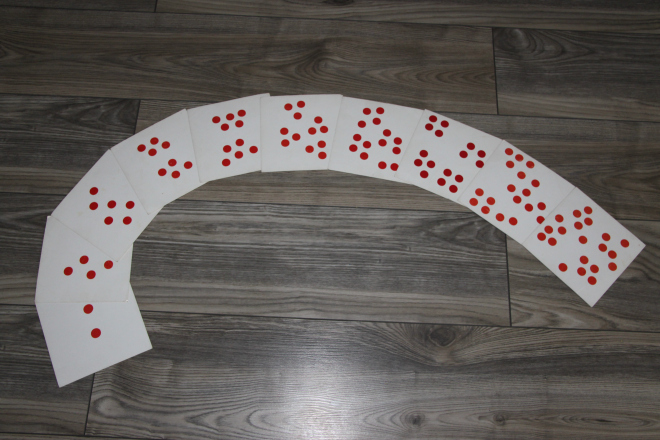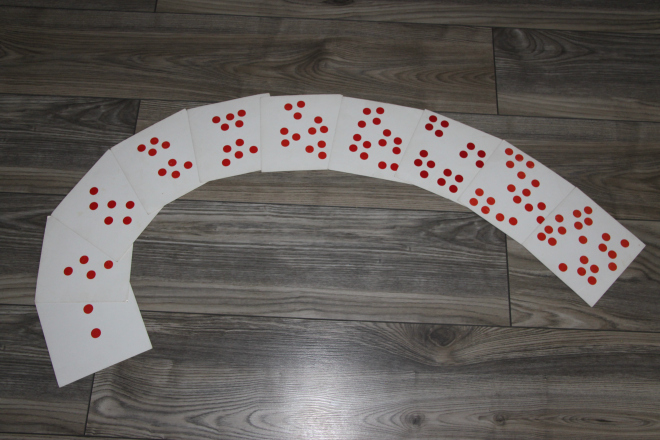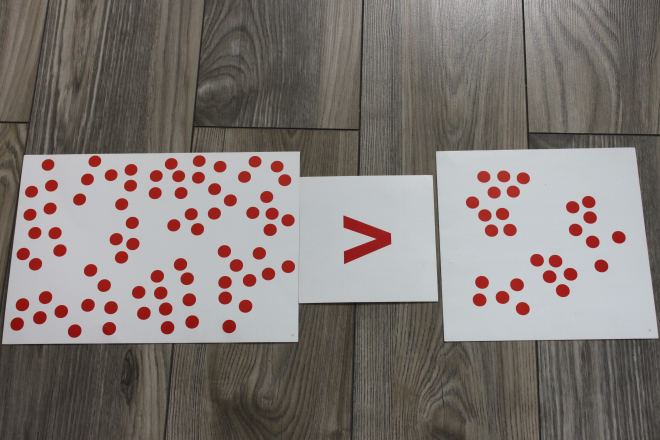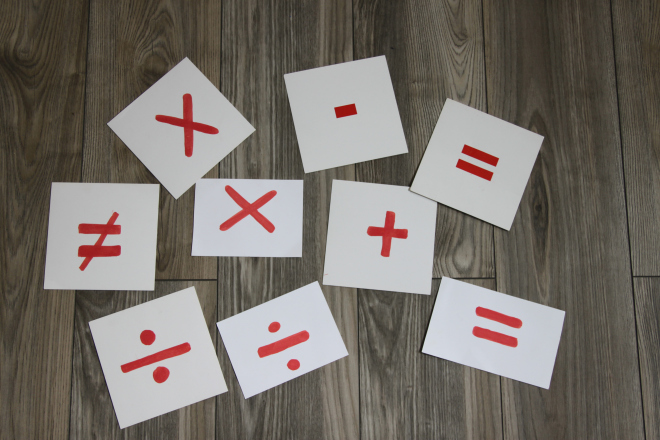

Glenn Doman
Summary:
- Introducing number sequences with dot cards
- My reflections and doubts related to the lack of a detailed programme for further steps in maths on dot cards
- My baby and her interest in number sequences
- On baby’s attention span and following your child, on short breaks from the programme
Number sequences with an 11-month-old baby
First day with number sequences
We have been doing all sorts of equations with flashcards with dot cards for weeks now. You will find the details in the previous arictle. I have decided this is a perfect moment to start the next step in the Doman method math: number sequences. Maja is exactly 11 months old.
I think it is a good idea to introduce new things gradually so in our morning session today we had the number sequence which you can see in the picture above: 2,4,6,8,10,12,14,16,18,20 instead of our usual 3 equations and a problem-solving opportunity. The equations are to be continued in the remaining two sessions. Tomorrow I am going to do two sessions with number sequences and the next day – three sessions. Then, for some time I am going to put away doing equations and focus on number sequences only.
Some thoughts in the lack of detailed instruction in Glenn Doman’s books
In his book: “How to Teach Your Baby Math” Glenn Doman discusses in detail the introduction of numbers 1-100 and basic equations like multiplication, division, addition and subtraction only. He also elaborates on giving problem-solving opportunities to our children as an alternative to testing and on making our children familiar with longer and longer equations. It seems we have already done the most important part of the Doman’s math programme. What’s next? According to Doman we have thousands of possibilities after completing this step. We as parents are only limited by our own imagination. Doman gives some examples of what we can do with our kids, however, I feel this part of his book is too general and it lacks detailed suggestions. Among those examples there are number sequences.
I wasn’t sure if I should follow the same strategy as before: 3 equations, 3 times daily. This would mean 3 number sequences, 3 times daily. Nevertheless, I came to a conclusion that showing more than one sequence like 2,4,6,8,10,12,14,16,18,20 will take much more time than showing three equations. I bear in mind that Maja is more active moving all the time and that her attention span has shortened drastically. That is why I have decided to show only 1 number sequence per session.
I had even more doubts about how many days I should dwell on presenting number sequences. There are no suggestions concerning this so I follow my maternal instincts. I will spend the same amount of time on these as on mixed equations – a few weeks.
I am going to Iceland to attend a course for teachers soon and because of this we will start the next step at the end of April after presenting a number of sequences.
Learning is fun – Maja’s reaction
I was really curious about my daughter’s attitude to something new with the red dots I have been flashing in front of her for a few months now. I did my best trying to put the cards down, one on the other as quickly as possible. I must admit I enjoyed it more than equations because I could do it much faster. We finished this session in a flash.
Maja was observing the cards with sheer curiosity. I was happy about it as it sometimes happens that it is really difficult to catch her attention. There is nothing unusual about this as it goes perfectly with Doman’s description of children at this age. My baby is really busy with discovering the world: climbing, finding another lamp in the house, picking up a new sound, spotting a crumb on the carpet and so on. She is so busy that literally she doesn’t have time to pay attention to the cards even for a few seconds 🙂 Yeah…I am smiling while writing this 🙂
On catching attention of a small child and following them
I know that we can’t expect a little child to sit down calmly with a serious look on their face focusing on the material we want to present and at the exact moment we want to show it. After all, there are so many interesting things around. Fortunately, according to Doman, a few seconds of attention is enough. Sometimes we have a few seconds in a row. Sometimes we need a break. On other occassions I need to get creative to catch Maja’s attention for a second and have her look at the card. But this is a topic for a separate article (right now available in Polish only).
However, I always respect my daughter’s feelings. I never interrupt her playing. When she plays I don’t present the cards. If it happens, she doesn’t want to look at them and she isn’t busy, I try one of my tricks and if they don’t work I understand she is not in the mood for the cards. I try again after 15-30 minutes. If it still doesn’t work, I give her a break. It happened a few times that she had an unplanned day off the cards although I was at home all the time. It needs to be like that and there is nothing to regret as we can’t push the child. It’s following your child.
“(…) we can’t expect a little child to sit down calmly with a serious look on their face focusing on the material we want to present and at the exact moment we want to show it.”
According to Glenn Doman occassional breaks from his programmes don’t do any harm. Actually, they may be very helpful. We have to avoid pushing our child to look at the cards. It is important that kids enjoy what we do with them and pushing them has nothing to do with joy. This also refers to a number of daily sessions. Every parent should modify the recommendations to his or her baby’s needs and to their own needs. How to do it? Maybe the interviews and series of articles on my blog on “How to start math depending on child’s age” will be helpful (right now available in Polish only). There is a similar series of articles on the reading programme.
It is possible to do 5 sets of reading cards daily with some children whereas in case of others one set is enough. It often happens that a working parent doesn’t have enough time to follow all Doman’s suggestions. Daily frequency and quantity is not so important. If you do it systematically and and both you and your child enjoy it, it is going to work. We shouldn’t push ourselves and our children to reach a recommended daily goal.
“Daily frequency and quantity is not so important. If you do it systematically and and both you and your child enjoy it, it is going to work.“
Have you found my experience useful? If yes, share with others.
You are welcome to read the rest of my blog.
Related articles:
Half a year with the Doman method
There is lots more in the Polish part but I haven’t managed to translate it yet.


